The black rhinoceros (Diceros bicornis) is a rhinoceros native to eastern and southern Africa. It is one of the two African species of rhinoceros, the other being the white rhino. The black rhino is known for its pointed upper lip and is smaller than its white relative.
Physical Traits
Black rhinos have two horns on their nose, with the front horn typically longer than the back horn. They are grey-brown and have thick skin, which helps protect them from thorns and sharp objects in their environment. They also have poor eyesight but an excellent sense of smell and hearing.
Life Span
The average life span of a black rhino in the wild is around 30 years, although some can live up to 50 years. In captivity, they can live up to 60 years or more.
Habitat
Black rhinos are found primarily in grasslands, savannahs, and tropical bushlands in sub-Saharan Africa, except in the Congo Basin. They prefer dense vegetation for cover and protection from predators such as lions, leopards, hyenas, and wild dogs.
Diet
Black rhinos are browsers that feed mainly on leaves, twigs, fruits, and buds from trees and shrubs. They also eat grasses when available but do not graze like cattle or sheep do.
Reproduction
Female black rhinos reach sexual maturity at 4-5 years old, while males reach maturity at 6-7. Mating usually occurs during the rainy season when food is plentiful, and gestation lasts 15-16 months before giving birth to a single calf. It will stay with its mother until it reaches 2-3 years old before becoming independent.
Conservation Status
The black rhino has been classified as critically endangered by IUCN due to poaching for their horns used in traditional Chinese medicine despite no scientific evidence that they have any medicinal value. The population has declined by 97% since 1960 due to poaching, but thanks to conservation efforts, it has been increasing since 1992, with current estimates showing around 5500 individuals remaining in the wild today.
Interesting Facts
- Black Rhinos can run up to 55 km/h (34 mph).
- They communicate through vocalizations such as grunts, snorts, and bellows, as well as body language such as head bobbing or rubbing against objects or other animals for scent-marking purposes.

